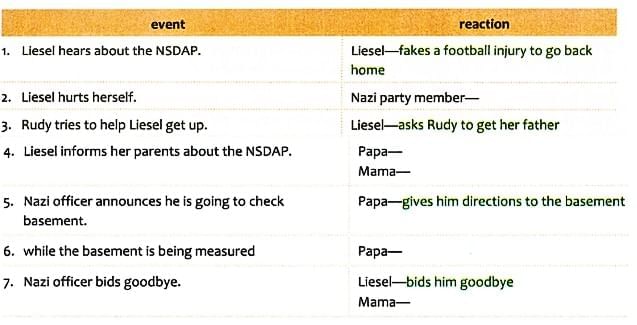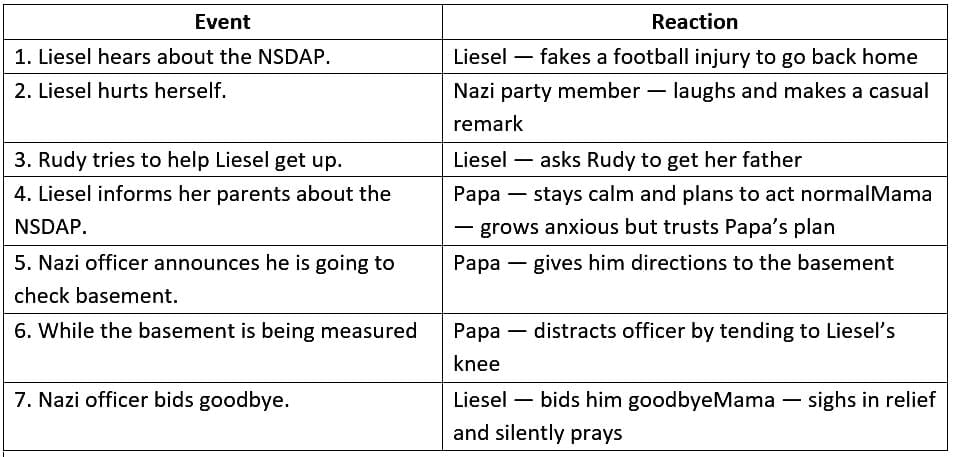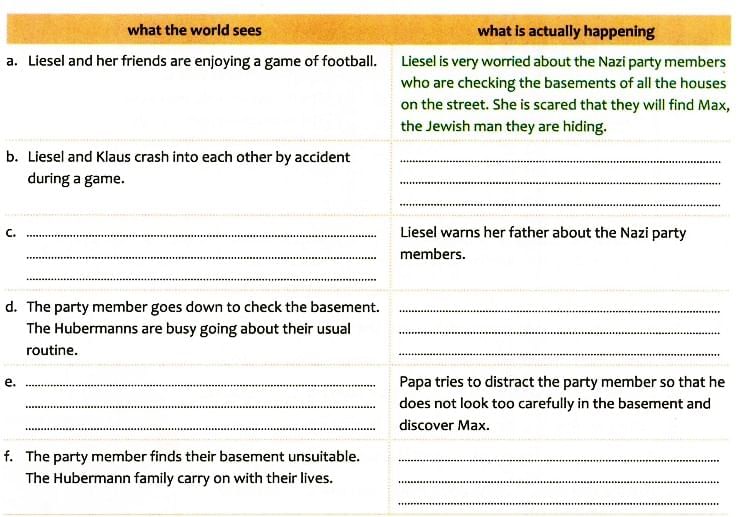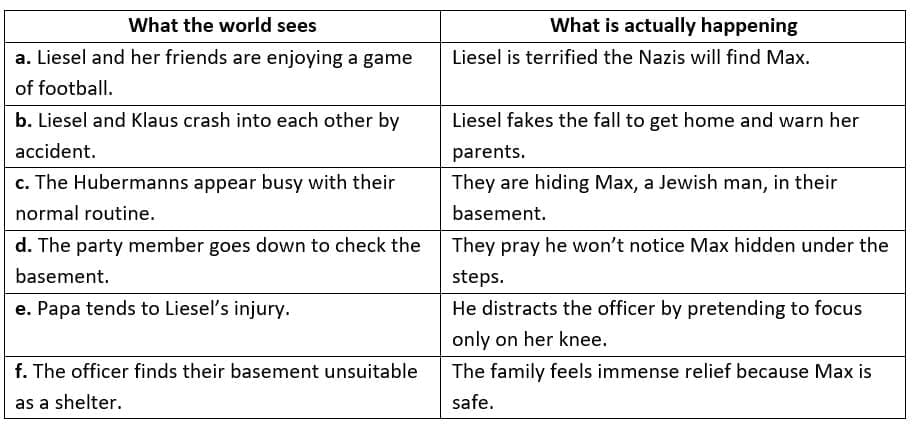Textbook Solutions: The Visitor | Gul Mohar Class 8: Book Solutions, Summaries & Worksheets PDF Download
| Table of contents |

|
| Before You Read |

|
| While Reading |

|
| Understanding the Text |

|
| Appreciating the Text |

|
Before You Read
Q. Sometimes we need to be brave to face difficult situations, but it takes a different kind of bravery to stand up for someone else. Tell your partner if you have ever had to stand up for someone else. What did you do? Why?Ans: Standing up for someone else is a test of courage and compassion. For instance, I once defended a classmate who was being mocked during a game. Though I was nervous, I knew remaining silent would encourage the wrongdoers. Speaking up was difficult, but I felt proud that I could support someone who needed help. Such bravery shows that real strength lies not only in protecting ourselves but also in protecting others from injustice and harm.
While Reading
Q1. This suggests Liesel is feeling .........?Ans: Liesel is suddenly overcome with fear and panic, and her dry mouth reflects the physical impact of terror. She realizes that the smallest mistake could expose Max, who is hiding in their basement. The intensity of her fear demonstrates how deeply she cares for Max’s safety. More importantly, it reveals the heavy burden placed on a young girl, forced to stay calm in an unimaginably dangerous and tense situation where one wrong move could cost lives.
Q2. Why should it look suspicious if Liesel went back home?
Ans: Returning home would look suspicious because Nazi officials were patrolling and checking houses. If Liesel suddenly left her friends during the game, the officers might wonder why she was rushing back. Any sudden or unusual action could draw unnecessary attention toward their house. This could have disastrous consequences, as their secret about Max would be uncovered. Liesel had to be clever and act naturally to avoid suspicion while still protecting her family’s dangerous secret.
Q3. What ‘slowed’?
Ans: In this context, it is not the clock that slows, but time itself. For Rosa, Papa, and Liesel, every second felt like an eternity as they anxiously waited for the Nazi officer to inspect the basement. The suspense of whether Max would be discovered made each moment unbearably long. This slowing of time mirrors their inner fear and heightens the tension for the reader, showing how suspense makes normal time feel stretched and never-ending.
Q4. Was this intentional? If so, what is Papa’s intention?
Ans: Yes, Papa’s action was intentional. When the Nazi officer was near the basement, Papa distracted him by fussing over Liesel’s injured knee. His intention was to draw attention away from the basement and make their family look normal and ordinary. By pretending to be worried only as a father, he cleverly disguised his anxiety about Max. This smart, quick-thinking action saved them by preventing suspicion and showed Papa’s intelligence and courage under extreme pressure.
Q5. Circle the correct answer. The capital letters suggest a:
a. big pause
b. tense wait
Ans: (b) a tense wait: The use of capital letters emphasizes the heavy silence and suspense hanging over the family. The words make the reader pause dramatically, just like the characters had to wait breathlessly for the officer’s decision. This typographical device adds intensity to the moment, forcing the reader to feel the same uneasiness and nervousness. The “tense wait” highlights how fear grips the characters and prolongs even the smallest events during moments of danger and risk.
Q6. How does this information influence us. Does it make the Nazi seem like an ordinary person?
Ans: When the Nazi officer smiles and even jokes with Liesel, we are influenced to see him as an ordinary man instead of a terrifying figure. This creates a sharp contrast with the hidden tension inside the Hubermanns’ home. For the family, he represents danger, yet his normal, almost friendly behavior shows irony. This duality increases suspense for the reader, because outward appearances seem safe, while in reality Max’s life hangs in fragile, hidden balance.
Q7. Liesel falls to her knees because ........?
Ans: Liesel falls to her knees out of sheer relief and exhaustion after hearing the officer’s judgment that their basement is too shallow for use as an air-raid shelter. This declaration means Max is safe from discovery, at least for the moment. All the fear, stress, and panic she had controlled inside herself suddenly leave her body. Her physical collapse symbolizes the release of unbearable tension and highlights the weight of responsibility she carried on herself.
Understanding the Text
A. Let us take a walk through the events in the story and the reactions of the characters to them. Complete this table based on your reading of the story.
 Ans:
Ans:
B. Answer these questions.
Q1. Think, Liesel—She had it. That’s it, she decided, but I have to make it real. (para 14)a. What was Liesel planning? Why?
Ans: Liesel was planning to pretend that she was injured while playing football. This excuse would allow her to leave the game and return home without attracting unwanted suspicion. She knew she had to act quickly because time was running out and the Nazis were already moving through the street. By creating a believable reason to leave, she was able to protect her family and give Papa an early warning about the danger approaching.
b. Why did she have to make ‘it’ real?
Ans: Liesel had to make her fake injury appear absolutely real, because the Nazis were observant and suspicious of any unusual behavior. If they thought she was pretending, they might have followed her back home. Such a move would have been disastrous, as it could expose Max hiding in their basement. Her need to make it real shows her intelligence, resourcefulness, and maturity beyond her age in handling a life-threatening situation calmly.
Q2. Papa was strict. “Nothing. We don’t even go down there—not a care in the world.” (para 40)
a. What was Papa’s plan to prevent the Nazi officer from finding Max?
Ans: Papa’s plan was surprisingly simple but very clever: do nothing unusual. He wanted the entire family to behave calmly and naturally, as though there was no secret to hide. By acting like a normal family without extra attention to the basement, the officer would not suspect anything. Pretending ignorance and normalcy was their strongest shield, because nervous actions could have revealed the truth. His advice demonstrated careful thought and strong self-control.
b. Why do you think he wanted to pretend as though they did not have ‘a care in the world’?
Ans: Pretending to be carefree was essential to survival. If the officer noticed fear, nervousness, or unnatural behavior, he might have become suspicious and checked more carefully. Papa knew that their best chance was to remain calm and act as though the inspection was routine and unimportant. This shows his wisdom and courage—understanding that calmness in the face of danger can sometimes be the most effective way to protect one’s family.
Q3. Liesel could not ward off the thought of Max … hugging it to his chest. (para 57)
a. Do you think Liesel and the Hubermanns were fond of Max? Or were they only worried about being punished for helping a Jew?
Ans: Liesel and the Hubermanns were truly fond of Max and cared for him deeply as part of their family. Their concern was not only fear of punishment but genuine love and loyalty toward him. Liesel’s quick action to warn Papa, Rosa’s desperate prayers, and Papa’s risky attempt to distract the Nazi show their emotional bond. Their actions reveal humanity, compassion, and a willingness to sacrifice their safety for Max’s survival and dignity.
b. Can you find examples from the text to support your answer?
Ans: Yes, there are many examples. Liesel risked being noticed by faking an injury just to warn her father. Papa bravely distracted the officer by tending to Liesel’s knee, while Rosa silently prayed in fear. Each of them thought more about Max’s safety than their own. These small yet powerful acts prove that their attachment to Max was not out of fear of punishment, but from deep affection and a strong sense of loyalty.
Q4. a. Max claims that he would not have used the pair of scissors he was found holding. Does para 68 tell us that for sure or is there some uncertainty?
Ans: The paragraph shows some uncertainty. Though Max insists he would not have used the scissors, his desperation and fear are clearly evident. In such extreme conditions, when survival instincts are at their strongest, we cannot be certain whether he might have acted differently. His words suggest he hoped to remain non-violent, but the fact that he held the scissors reveals his inner conflict and the uncertainty of human behavior under fear.
b. In your opinion, would Max have been justified in using the scissors on the Nazi?
Ans: In my opinion, Max would not have been justified, because attacking the Nazi would have endangered not only his life but also the Hubermanns. Violence might have exposed the entire family and led to severe punishment for everyone. However, his fear and desperation are understandable. It highlights the hopelessness Jews faced in Nazi Germany, where even basic survival forced them into impossible moral dilemmas between non-violence and self-defense.
Q5. How does Liesel prove herself to be a clever and resourceful girl with courage and self-control?
Ans: Liesel proves her cleverness by quickly thinking of faking an injury so she could leave the game unnoticed. Her resourcefulness is seen in how naturally she executed the plan, making it believable to the Nazis. Despite the life-threatening fear inside her, she controlled her panic and calmly warned Papa about the danger. Such bravery, quick thinking, and maturity in a young girl show remarkable strength of character and emotional resilience under immense pressure.
Appreciating the Text
Q. The Hubermanns seem to lead two different lives. What the world sees is a cheerful family that is no different from the others around them. But as a reader, you are aware that the family is keeping a dangerous secret and this helps to build the suspense in the story.Here is a table which details the contrast between what the world sees and what is actually happening in the Hubermanns' lives. Pair up with your partner and complete it.
 Ans:
Ans: 
|
32 videos|62 docs|17 tests
|
FAQs on Textbook Solutions: The Visitor - Gul Mohar Class 8: Book Solutions, Summaries & Worksheets
| 1. What are the main themes discussed in "The Visitor"? |  |
| 2. Who are the central characters in "The Visitor," and what roles do they play? |  |
| 3. How does "The Visitor" depict the concept of cultural exchange? |  |
| 4. What lessons can readers learn from "The Visitor"? |  |
| 5. In what ways does "The Visitor" reflect real-life situations regarding immigration and cultural diversity? |  |















